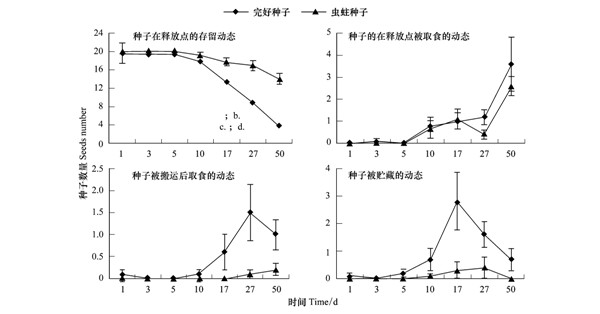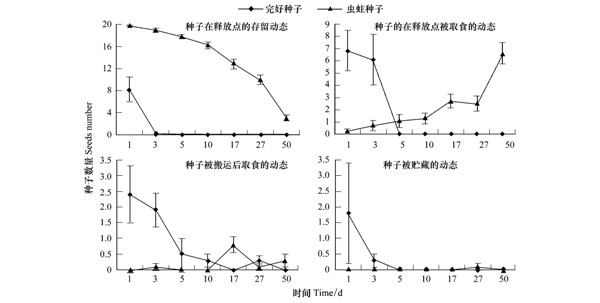文章信息
- 张博, 石子俊, 陈晓宁, 廉振民, 常罡
- ZHANG Bo, SHI Zijun, CHEN Xiaoning, LIAN Zhenmin, CHANG Gang
- 昆虫蛀蚀对鼠类介导下的锐齿槲栎种子扩散的影响
- Effects of weevil-infestation on seed dispersal of Quercus aliena handled by rodents
- 生态学报, 2014, 34(14): 3937-3943
- Acta Ecologica Sinica, 2014, 34(14): 3937-3943
- http://dx.doi.org/10.5846/stxb201211271683
-
文章历史
- 收稿日期:2012-11-27
- 修订日期:2014-2-27
2. 陕西省动物研究所, 西安 710032
2. Shaanxi Institute of Zoology, Xi'an 710032, China
种子是大部分森林鼠类的主要食物,一些森林鼠类会将部分种子分散埋藏在落叶下或土壤浅层,为交配、繁殖或食物短缺期贮备食物[1, 2]。这些被鼠类分散贮藏的种子有少量将来可能会逃脱捕食或微生物侵害,并遇到适于幼苗萌发和建成的环境条件而成功建成幼苗,实现植物的自然更新[3, 4, 5, 6]。因此,森林鼠类分散贮藏种子的行为能在一定程度上促进植物种子的扩散,在植物更新过程中扮演着重要的角色[7, 8]。
通常情况下,种子的质量是影响动物决定觅食或贮藏的重要因素[1]。昆虫作为扩散前的种子捕食者,它们常在种子成熟过程中即寄生于植物种子,引起种子胚的破坏,从而降低种子对森林鼠类的吸引力,影响其扩散和更新[9, 10]。然而,森林鼠类是否具有鉴别虫蛀种子的能力一直存在很大的争议。一些研究认为森林鼠类能够准确的识别虫蛀种子[11, 12, 13]。如有研究表明,北美灰松鼠(Sciurus carolinesis)可以区别对待完好和虫蛀橡子(Quercus nigra)[11];有的研究也表明鼠类能准确地鉴别虫蛀种子,从而有区别地搬走并贮藏更多的完好种子,消耗一部分可以利用的虫蛀种子及其寄生昆虫。这可能大大地影响来年寄生昆虫的种群数量,同时增加有活力种子的比例,从而有益于植物的繁殖成功[12]。而另外一些研究则认为森林鼠类不能分辨虫蛀和完好种子[14]。如有研究表明,白足鼠(Peromyscus leucopus)对完好和虫蛀橡子(Quercus alba)的取食不受昆虫寄生的影响[14]。由此可见,对于鼠类是否能够准确鉴别虫蛀种子还有待进一步的研究。
食物丰富度也是影响鼠类对种子选择的一个重要因素[15, 16]。在食物匮乏时期,鼠类为了满足其日常的能量需求,只能大量的取食有限的种子,减少其贮藏量;而在食物丰盛时期,鼠类在满足其日常能量需求的同时,还有大量剩余的种子供其贮藏[17]。如有研究表明,在食物丰富度较高的年份,鼠类对山杏(Prunus armeniaca)的搬运速率较慢,搬运距离较远,分散贮藏的比例较高[16]。然而,在不同食物丰富度条件下,究竟鼠类如何鉴别虫蛀种子则很少有报道。
锐齿槲栎(Quercus aliena)是分布在秦岭地区的一种优势落叶阔叶树种,其种子是森林鼠类重要的食物来源[18, 19]。本研究旨在调查森林鼠类是否具备对完好和虫蛀锐齿槲栎种子的鉴别能力,倘若森林鼠类具有鉴别虫蛀种子的能力,则其在不同食物相对丰富度下,对锐齿槲栎种子的选择策略又会有何不同?期望通过解答以上问题,为秦岭锐齿槲栎的自然扩散和更新提供一些科学依据。
1 材料与方法 1.1 研究地点本研究分别于2011年秋季(9—11月,食物丰富季节)和2012年春季(3—5月,食物匮乏季节)在秦岭南坡的佛坪国家级自然保护区进行。该保护区位于秦岭南坡中段,气候处于北亚热带向暖温带过渡区的北缘,年均气温11.4℃,年均降水943 mm。研究样地位于海拔2000 m以下的低中山典型落叶阔叶林带内,该林带内常见的壳斗科植物主要有板栗(Castanea mollissima)、栓皮栎(Q. variabilis)、锐齿槲栎和小橡子树(Q. glandulifera)等。该保护区分布的啮齿动物主要有小家鼠(Mus musculus)、甘肃仓鼠(Cansumys canus)、中华姬鼠(Apodemus draco)、大林姬鼠(A. peninsulae)、黑线姬鼠(A. agrarius)、高山姬鼠(A. chevrieri)、褐家鼠(Rattus norvegicus)、针毛鼠(R. fulvescens)、社鼠(R. niviventer)、岩松鼠(Sciurotamias davidianus)和花鼠(Eutamias sibiricus)等[20]。
1.2 实验种子及标记方法锐齿槲栎隶属于壳斗科(Fagaceae)栎属(Quercus),落叶乔木,花期3—4月,果期9—10月。壳斗杯状,坚果椭圆形至卵形。天然分布于辽宁东南部、河北、山西、陕西、甘肃、山东、江苏、安徽、江西、台湾、河南、湖北、湖南、广东、广西、四川、贵州、云南等省区[21]。秦岭南北坡均有分布,较为常见,生于海拔700—2000 m的山坡上,常自生成纯林,在南坡常与马尾松组成松栎林[22]。
当锐齿槲栎种子成熟时(9—10月),在野外收集新鲜种子用于当年实验。将部分剩余种子与干沙混匀后保存在塑料桶内用于次年春季的实验,该保存法借鉴于当地人保存板栗的方法,经实验证明可以保证大部分种子质量不变。每次实验前按照表面是否有昆虫产卵时留下的产卵孔作为依据,同时考虑种子的坚硬程度,将种子分为完好和虫蛀2种类型。种子筛选后存放20 d再进行实验,目的是确保鉴别准确。本研究采用塑料片标签法对实验种子进行标记。具体的标记操作方法是用手电钻在种子子叶部分打出一个约0.7 mm的小孔,然后用一根长约15 cm的细钢丝将种子和一个白色塑料片(3 cm× 3 cm,< 0.15 g)连接起来。由于种子的胚是完整的,因而不会影响种子的萌发。每个塑料片的正反面用记号笔标上数字,用来区别每一粒种子[18]。通过野外及围栏的研究表明,塑料片和细钢丝对鼠类鉴别、搬运及埋藏种子没有显著影响[23, 24]。
1.3 实验设计及步骤2011年10月(秋季),在研究地区选取地势较为平缓的落叶阔叶林带作为实验样地,坡向向南,在实验样地内随机选择10个样点作为种子释放点,单个样点大小为1 m× 1 m,样点间相距15 m左右。每个样点同时放入标记的完好和虫蛀种子各20粒。种子扩散的调查时间为释放后的第1,3,5,10,17,27,50天,调查范围是以每个种子释放点为中心30 m以内。调查时记录每个样点所有种子的命运及扩散距离(丢失的种子未作统计分析)。2012年4月(春季)在相同样地重复上述实验。
种子命运分为以下4种[18]:(1)存留,种子在释放点完好保留,未被取食或移动;(2)原地取食,种子在释放点被取食;(3)扩散取食,种子被搬运后取食;(4)贮藏,种子被埋藏于地表。
1.4 统计与分析在Microsoft Office Excel(Ver.2007)上以种子调查时间为横坐标,以种子命运相应的单日数量(贮藏为累积量)平均值为纵坐标,以标准误为误差线作图。所有数据统计均在SPSS for windows(Ver.18.0)软件上分析。Cox Regression用来比较2个季节完好与虫蛀种子在释放点存留动态的差异;Two-Way ANOVA用来比较2个季节完好与虫蛀种子被原地取食、被扩散取食和被贮藏时间动态上的差异;独立样本T检验用来比较2个季节完好与虫蛀种子在贮藏距离上的差异。
2 结果 2.1 扩散后的种子命运尽管完好与虫蛀种子在秋季的存留动态不存在显著差异(Wald=1.554,df=1,P=0.212),但是在后期鼠类逐渐更多地扩散完好种子(图 1)。而2种类型种子在春季的存留动态则差异极显著(Wald=129.30,df=1,P<0.001),几乎所有的完好种子(99%)在释放后的第3天就被鼠类全部扩散,虫蛀种子的存留时间则相对较长(图 2)。

|
| 图 1 完好与虫蛀锐齿槲栎种子在秋季的命运动态 Fig. 1 Seed fates dynamics of intact and weevil-infested Q. aliena seeds in autumn |

|
| 图 2 完好与虫蛀锐齿槲栎种子在春季的命运动态 Fig. 2 fates dynamics of intact and weevil-infested Q. aliena seeds in spring |
完好与虫蛀种子在秋季的原地被取食动态上没有显著差异(F6,400=0.540,P=0.777),而在春季的原地被取食动态上则差异极显著(F6,400=16.839,P<0.001)。在春季,鼠类优先取食完好种子,前5d取食了约64.5%的完好种子,而对虫蛀种子的取食则在后期逐渐增加(图 1,图 2)。
完好与虫蛀种子在秋季(F6,400=5.720,P<0.001)和春季(F6,400=2.729,P=0.016)的扩散后被取食动态上都存在显著差异。尤其在春季,鼠类在实验前期主要搬运取食完好种子(图 1,图 2)。
完好与虫蛀种子在秋季的贮藏动态上存在极显著差异(F6,400=3.780,P<0.001),鼠类贮藏了更多的完好种子(图 1)。在春季,尽管完好种子在释放后第1天便达到贮藏高峰,然而由于后期的大量被捕食,完好与虫蛀种子在贮藏动态没有表现出显著差异(F6,400=1.250,P=0.286)(图 2)。
2.2 种子扩散距离在秋季,完好种子被贮藏的平均距离是(1.15±0.13) m,虫蛀种子被贮藏的平均距离是(1.88±0.70) m,二者之间没有显著差异(P > 0.05)。在春季,完好种子被贮藏的平均距离是(1.53±0.18) m,虫蛀种子被贮藏的平均距离是2.0 m(虫蛀种子仅埋藏了1粒,无法统计比较)。由此可见,完好和虫蛀种子的扩散距离在两个季节内均无显著差异。
3 讨论本研究结果显示秦岭森林鼠类可以准确区分完好和虫蛀种子,这与肖治术等的研究结果相一致[12]。首先,种子在释放点的存留时间长短直接反映了鼠类对种子的偏好性,存留时间越长,说明鼠类越不喜好取食或搬运贮藏这类种子。本研究中虫蛀种子在2个季节的存留时间都长于完好种子。尤其在春季,完好种子在第3天即消失殆尽,而虫蛀种子在第50天仍有17%存留在释放点。其次,对于具有食物贮藏习性的森林鼠类而言,决定吃什么以及贮藏什么对其短期和长期存活是至关重要的。因此,在贮藏种子时,鼠类对种子具有一定的选择性,贮藏价值高的种子以确保获得较高的回报[25, 26]。通常情况下,由于虫蛀种子受损而使能量降低、适口性变差,鼠类较少贮藏它们[10, 11]。在本研究中,鼠类贮藏了更多的完好种子,说明鼠类对种子的品质具有一定的鉴别能力。
对食种子鼠类而言,鉴别和选择不同质量的种子对它们的生存是非常重要的。虫蛀种子的可食用部分较完好种子少,同时容易发霉腐烂,对于鼠类而言埋藏虫蛀种子的收益就非常小。但虫蛀种子内的昆虫幼虫仍有利用价值,可以作为鼠类食物的补充。本研究发现虽然鼠类能够区分完好和虫蛀种子,但并非完全拒绝虫蛀种子(部分取食)。通过取食虫蛀种子和种子内的昆虫幼虫,可以减少随后年份内害虫种群的数量,对次年种子质量的提升具有一定的促进作用[12]。
本研究发现食物丰富度会影响鼠类的选择策略。在食物丰富的秋季,鼠类贮藏完好种子是一个渐变的过程,在中期达到贮藏的最高值,被埋藏种子的存留时间较长。而在春季,种子在释放点的消失速率非常快,尽管完好种子仍然被相对较多的埋藏,但是埋藏的种子在实验第3天就被取食殆尽,存留时间非常短。在取食策略上,春季虫蛀种子被取食的数量明显高于秋季。由此可见,与食物丰富度紧密联系的季节变化,对鼠类的选择策略和鉴别能力有着非常重要的影响。在食物丰盛的时期,鼠类有更多的选择去贮藏完好种子。而在食物匮乏的时期,鼠类为了满足自身的食物和能量需求,它们的贮藏行为明显减弱,对两种类型种子均以取食居多。
本研究发现大部分被埋藏的种子最终将被取食。截至本实验结束,仅秋季剩余4粒完好种子仍被埋藏,其它被埋藏的种子均被取食。这个结果可能与本实验的样本量较少有关,结合同期的其它实验以及其它研究人员的相关研究结果可知,被埋藏的种子是有可能建成幼苗并存活下来的[27]。考虑到自然界种子的丰富产量,尤其在秋季,会有更多被鼠类贮藏的完好种子成功逃避捕食而萌发建成幼苗,实现植物的自然更新。
贮藏距离也是反映鼠类对种子喜好程度的一个重要指标。根据最优贮藏空间分布模型的预测,分散贮藏的动物喜好将价值较低的食物贮藏在资源点附近,而将价值较高的食物贮藏在远离资源点的地方[28],然而在本研究中,完好和虫蛀种子的贮藏距离没有显著差异,这是因为本研究中较多的完好种子前期被原地埋藏,随后又被不断取食,导致平均贮藏距离较短;而虫蛀种子原地被埋藏的数量则比较少。这与实验的样本量较少也有一定的关系,如果样本量充足,那么前期在原地被埋藏的种子就有可能被鼠类搬运进行二次甚至多次埋藏。
本研究在实验开始前用活捕笼(27 cm×14 cm×14 cm)通过笼捕法,在实验样地内对鼠类群落结构进行了简单调查[17]。2011年秋季共捕获鼠类14只,其中中华姬鼠数量最多,占总数的85.8%。同时捕获到少量的社鼠(7.1%)和岩松鼠(7.1%)。2012年春季共捕获鼠类19只,全部为中华姬鼠(100%)。由此可见,两个季节鼠类的群落结构变化并不大,可以排除鼠类种群数量变化对两个季节种子取食和贮藏的影响。此外,通过室内饲养,社鼠、中华姬鼠、岩松鼠等均取食锐齿槲栎种子,通过比较后发现种子被取食的种壳残渣形态及种子的咬痕与野外的基本一致,由此可以确定野外种子的扩散基本是由这些鼠类完成的。
总而言之,研究结果表明秦岭森林鼠类可以准确区分完好与虫蛀种子,但是食物丰富度会影响鼠类对种子的选择策略。在食物丰富的秋季,鼠类更多的选择贮藏完好种子;而在食物相对匮乏的春季,鼠类的选择更倾向于同时取食2种类型种子。森林鼠类通过对2种类型种子的鉴别和选择,影响不同种子的命运,从而可能对种子的扩散和自然更新产生重要影响。
| [1] | Smith C C, Reichman O J. The evolution of food caching by birds and mammals. Annual Review of Ecology and Systematics, 1984, 15(1): 329-351. |
| [2] | Vander Wall S B. Food Hoarding in Animals. Chicago: University of Chicago Press, 1990. |
| [3] | Gomez J M, Puerta-Pinero C, Schupp E W. Effectiveness of rodents as local seed dispersers of Holm oaks. Oecologia, 2008, 155(3): 529-537. |
| [4] | Schupp E W, Jordano P, Gomez J M. Seed dispersal effectiveness revisited: a conceptual review. New Phytologist, 2010, 188(2): 333-353. |
| [5] | Vander Wall S B, Joyner J W. Recaching of Jeffrey pine (Pinus jeffreyi) seeds by yellow pine chipmunks (Tamias amoenus): potential effects on plant reproductive success. Canadian Journal of Zoology, 1998, 76(1): 154-162. |
| [6] | Xiao Z S, Zhang Z B. Nut predation and dispersal of harland tanoak Lithocarpus harlandii by scatter-hoarding rodents. Acta Oecologica, 2006, 29(2): 205-213. |
| [7] | Li H J, Zhang Z B. Relationship between animals and plant regeneration by seed Ⅱ. Seed predation, dispersal and burial by animals and relationship between animals and seedling establishment. Biodiversity Science, 2001, 9(1): 25-37. |
| [8] | Jansen P A, Forget P M. Scatterhoarding rodents and tree regeneration // Bongers F, Charles-Dominique P, Forget P M, eds. Nouragues: Dynamics and Plant-Animal Interactions in a Neotropical Rainforest. Dordrecht: Kluwer Academic Publishers, 2002: 275-288. |
| [9] | Sallabanks R, Courtney S P. Frugivory, Seed predation, and insect-vertebrate interactions. Annual Review of Entomology, 1992, 37(1): 377-400. |
| [10] | Xiao Z S, Harris M K, Zhang Z B. Acorn defenses to herbivory from insects: Implications for the joint evolution of resistance, tolerance and escape. Forest Ecology and Management, 2007, 238(1): 302-308. |
| [11] | Steele M A, Hadj-Chikh L Z, Hazeltine J. Caching and feeding decisions by sciurus carolinensis: Responses to weevil-infested acorns. Journal of Mammalogy, 1996, 77(2): 305-314. |
| [12] | Xiao Z S, Zhang Z B, Wang Y S. Rodent's ability to discriminate weevil-infested acorns: potential effects on regeneration of nut-bearing plants. Acta Theriologica Sinica, 2003, 23(4): 312-320. |
| [13] | Smallwood P D, Steele M A, Faeth S H. The ultimate basis of the caching preferences of rodents, and the oak-dispersal syndrome: tannins, insects, and seed germination. American Zoologist, 2001, 41(4): 840-851. |
| [14] | Semel B, Andersen D C. Vulnerability of acorn weevils (Coleoptera: Curculionidae) and attractiveness of weevils and infested Quercus alba acorns to Peromyscus leucopus and Blarina brevicauda. American Midland Naturalist, 1988, 119(2): 385-393. |
| [15] | Vander Wall S B. Masting in animal-dispersed pines facilitates seed dispersal. Ecology, 2002, 83(12): 3508-3516. |
| [16] | Li H J, Zhang Z B. Effects of mast seeding and rodent abundance on seed predation and dispersal by rodents in Prunus armeniaca (Rosaceae). Forest Ecology and Management, 2007, 242(2/3): 511-517. |
| [17] | Chang G, Wang K F, Wang Z. Effect of forest rodents on predation and dispersal of Pinus armandii seeds in Qinling Mountains. Acta Ecologica Sinica, 2012, 32(10): 3177-3181. |
| [18] | Chang G, Tai F D. Effects of seasonal change on dispersal of Quercus aliena seeds. Chinese Journal of Ecology, 2011, 30(1): 189-192. |
| [19] | Chang G, Jin T Z, Pei J F, Chen X N, Zhang B, Shi Z J. Seed dispersal of three sympatric oak species by forest rodents in the Qinling Mountains, Central China. Plant Ecology, 2012, 213(10): 1633-1642. |
| [20] | Zhang F C, Yang X Z, Gong H S. Community structure of rodents in Foping Nature Reserve. Chinese Journal of Wildlife, 2007, 28(1): 13-17. |
| [21] | Flora of China Editorial Committee. Flora Reipublicae Popularis Sinicae. Beijing: Science Press, 1998, 22: 230-231. |
| [22] | Northwest Institute of Botany, Chinese Academy of Sciences. Flora of Qinling Mountains. Beijing: Science Press, 1974, 1(2): 80-80. |
| [23] | Xiao Z S, Jansen P A, Zhang Z B. Using seed-tagging methods for assessing post-dispersal seed fate in rodent-dispersed trees. Forest Ecology and Management, 2006, 233(1/3): 18-23. |
| [24] | Chang G. Comparison of several tag-marked methods in seed dispersal by rats. Chinese Journal of Ecology, 2012, 31(3): 684-688. |
| [25] | Chang G, Xiao Z S, Zhang Z B. Hoarding decisions by Edward's long-tailed rats (Leopoldamys edwardsi) and South China field mice (Apodemus draco): The responses to seed size and germination schedule in acorns. Behavioural Processes, 2009, 82(1): 7-11. |
| [26] | Wang B, Chen J. Seed size, more than nutrient or tannin content, affects seed caching behavior of a common genus of Old World rodents. Ecology, 2009, 90(11): 3023-3032. |
| [27] | Cao L, Xiao Z S, Guo C, Chen J, Zhang Z B. Scatter-hoarding rodents as secondary seed dispersers of a frugivore-dispersed tree Scleropyrum wallichianum in a defaunated Xishuangbanna tropical forest, China. Integrative Zoology, 2011, 6(3): 227-234. |
| [28] | Stapanian M A, Smith C C. Density-dependent survival of scatterhoarded nuts: an experimental appoach. Ecological Society of America, 1984, 65(5): 1387-1396.[7] 李宏俊, 张知彬. 动物与植物种子更新的关系Ⅱ. 动物对种子的捕食、扩散、贮藏及与幼苗建成的关系. 生物多样性, 2001, 9(1): 25-37. |
| [17] | 常罡, 王开锋, 王智. 秦岭森林鼠类对华山松(Pinus armandii)种子捕食及其扩散的影响. 生态学报, 2012, 32(10): 3177-3181. |
| [18] | 常罡, 邰发道. 季节变化对锐齿栎种子扩散的影响. 生态学杂志, 2011, 30(1): 189-192. |
| [20] | 张凤臣, 杨兴中, 巩会生. 陕西佛坪自然保护区啮齿动物群落结构研究. 野生动物, 2007, 28(1): 13-17. |
| [21] | 中国科学院中国植物志编辑委员会. 中国植物志. 北京: 科学出版社, 1998, 22: 230-231. |
| [22] | 中国科学院西北植物研究所. 秦岭植物志. 北京: 科学出版社, 1974, 1(2): 80-80. |
| [24] | 常罡. 鼠类扩散种子的几种标签标记法的比较. 生态学杂志, 2012, 31(3): 684-688. |
 2014, Vol. 34
2014, Vol. 34




